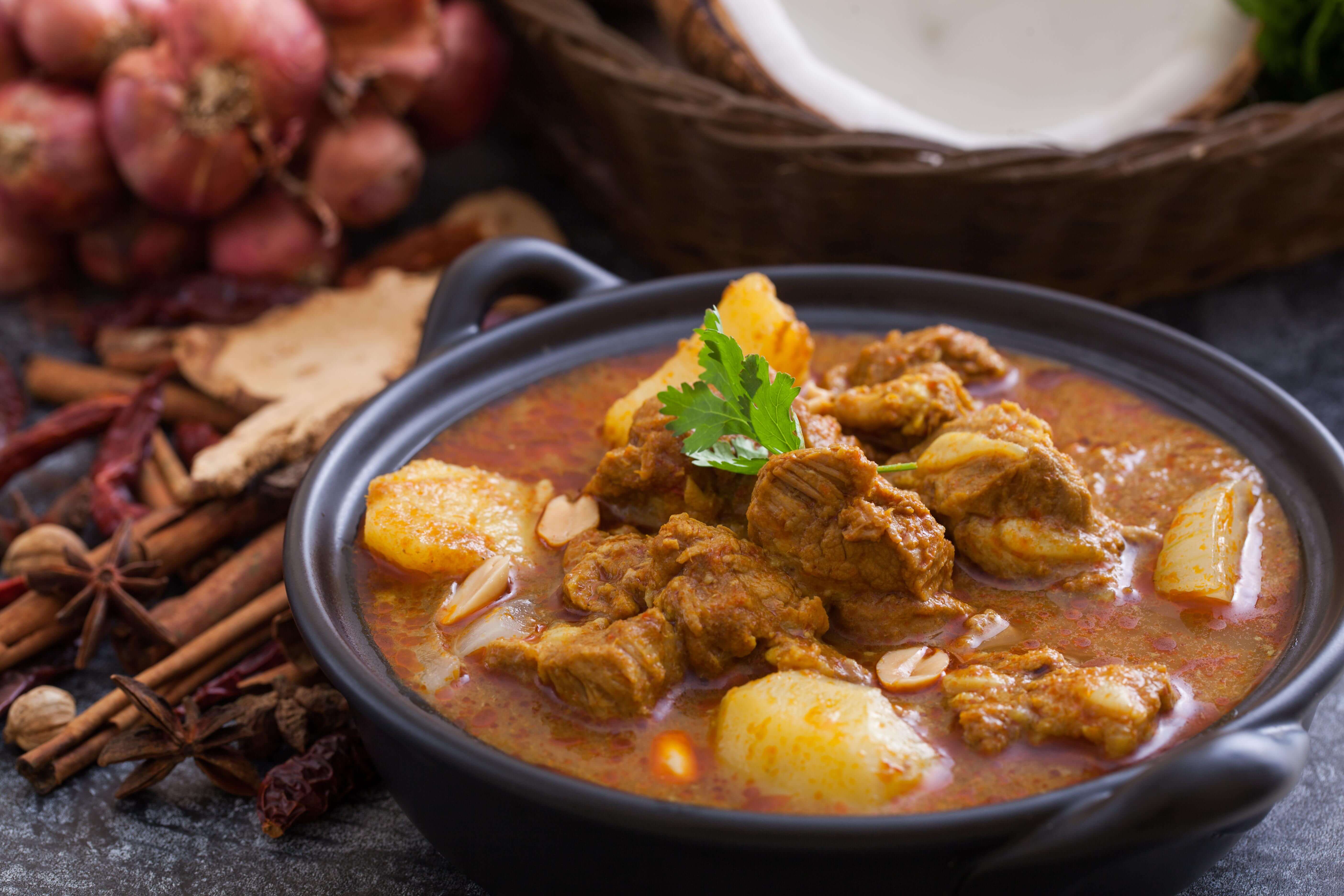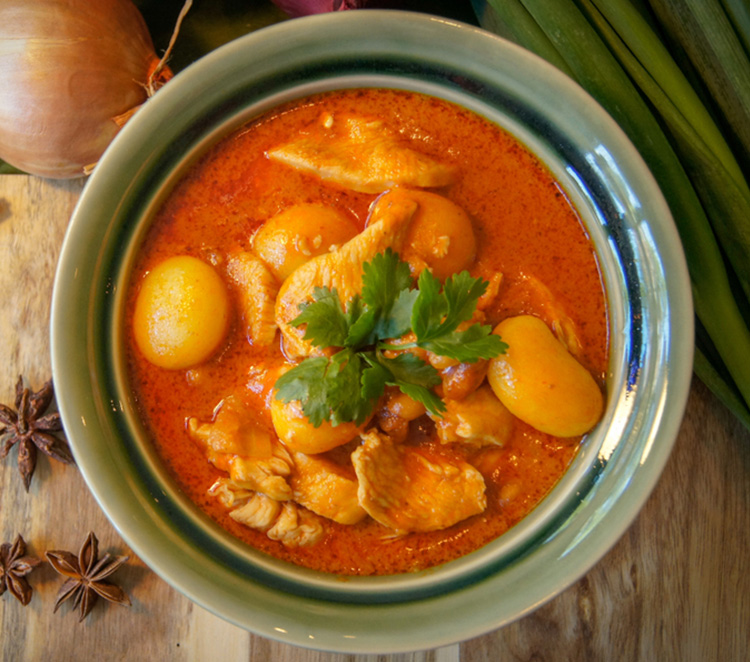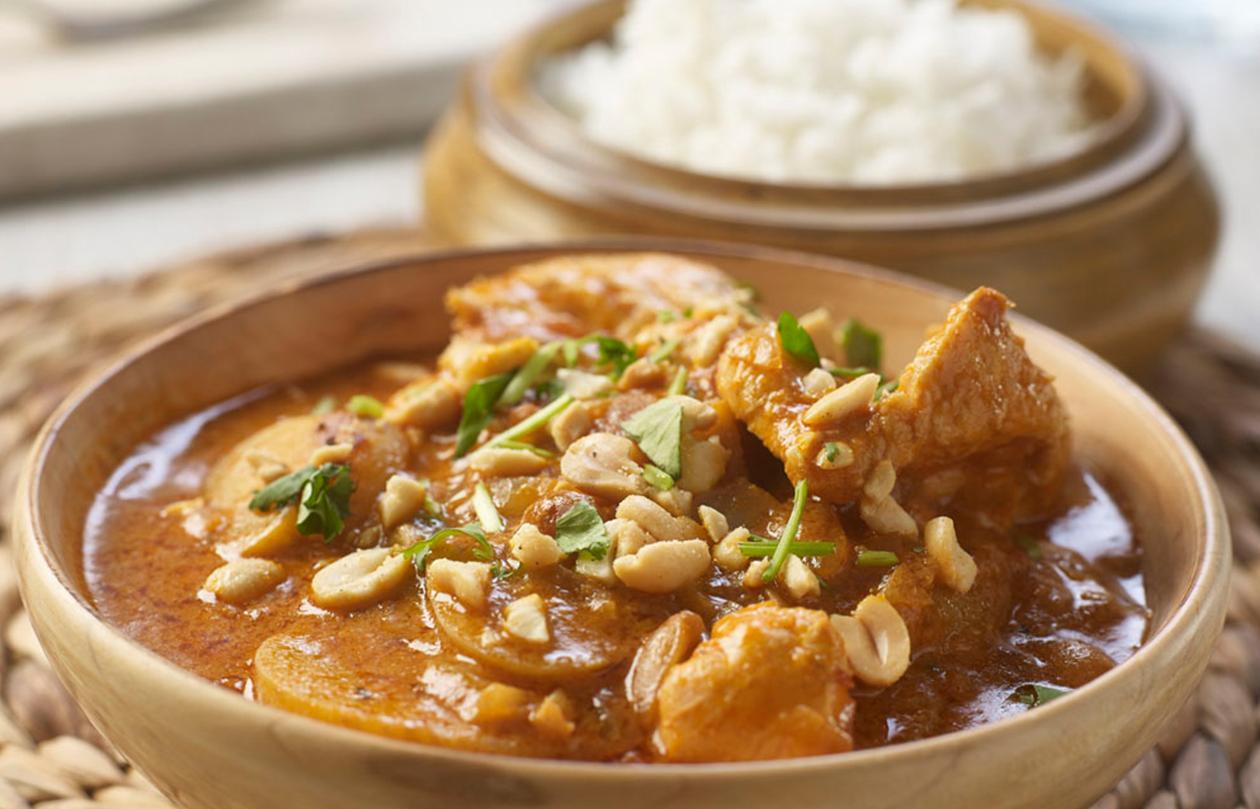The History of Massaman curry and Recipe
Massaman curry, also spelled "Matsaman" or "Masaman," is a type of Thai curry that has a unique and distinctive flavor profile. The history of Massaman curry is intertwined with the cultural and culinary influences that have shaped Thai cuisine over the centuries.
The origins of Massaman curry can be traced back to the 17th century, during the Ayutthaya Kingdom in what is now Thailand. The curry is believed to have been influenced by Persian and Indian culinary traditions, as traders and immigrants from these regions had contact with the Ayutthaya Kingdom at that time. The name "Massaman" is thought to be derived from the word "Mussulman," which refers to followers of Islam.
The dish typically features a rich and flavorful curry sauce made with a blend of aromatic spices such as cinnamon, cardamom, cloves, and nutmeg. Peanuts or cashew nuts are often included to add a creamy texture to the curry. Massaman curry can be made with various proteins, including beef, chicken, or lamb, and it often includes potatoes or other vegetables.
The unique combination of spices and ingredients in Massaman curry reflects the diverse cultural influences that have shaped Thai cuisine. Over the years, the recipe has evolved, and different variations of Massaman curry can be found throughout Thailand and in various Thai restaurants around the world.:max_bytes(150000):strip_icc()/__opt__aboutcom__coeus__resources__content_migration__serious_eats__seriouseats.com__images__2017__03__20170210-chicken-massaman-emily-matt-clifton-3-1500x1125-a79cdda8bb364bffba432aea55d1536b.jpg)
Today, Massaman curry is celebrated for its complex and delicious flavor profile, blending the sweet, savory, and aromatic elements into a harmonious dish. It has become a popular choice for those seeking a taste of Thai cuisine with a distinctive and historical twist.:max_bytes(150000):strip_icc()/5871033-slow-cooker-chicken-massaman-curry-JenniferCooks-4x3-1-c069d822649d47809927c51294aa89fc.jpg)
- Historical Influences:
During the Ayutthaya Kingdom, Thailand (formerly known as Siam) was a major trading hub, welcoming merchants and traders from various regions, including Persia, India, and the Middle East.
The cultural exchange between Thai locals and these foreign traders led to the introduction of new ingredients, spices, and cooking techniques.
- Etymology:
The name "Massaman" is believed to have originated from the word "Mussulman," which refers to Muslims. This reflects the Islamic influence on the dish, evident in the use of certain spices like cardamom and the incorporation of techniques like dry roasting.
- Persian and Indian Influences:
Massaman curry exhibits clear influences from Persian and Indian cuisines. The use of spices like cumin, coriander, and cardamom, as well as the inclusion of nuts like peanuts or cashews, reflects the Persian and Indian culinary traditions.
- Culinary Fusion:
Massaman curry is considered a fusion dish, blending Thai flavors with foreign elements. This fusion is evident in the diverse mix of ingredients, including traditional Thai ingredients like lemongrass and galangal alongside foreign spices and nuts.
- Evolution Over Time:
The recipe for Massaman curry has evolved over time, with variations emerging based on regional preferences and ingredient availability.
While the dish was initially associated with the Muslim communities in Thailand, it has become popular among people of all backgrounds.
- Recognition and Global Popularity:
Massaman curry gained international recognition as Thai cuisine became more popular worldwide. Its unique flavor profile, combining sweet, savory, and aromatic elements, contributed to its appeal.
- Cultural Significance:
Massaman curry is often associated with special occasions and celebrations in Thailand. It has become a dish that symbolizes the diverse cultural influences that have shaped Thai culinary traditions.
In summary, Massaman curry's history is a testament to the cultural openness of Thailand and its ability to integrate foreign influences into its own culinary repertoire. Today, Massaman curry remains a beloved and iconic Thai dish, enjoyed both in its country of origin and around the world.
Massaman Curry Recipe;

Ingredients:
For the Massaman Curry Paste:
- 4-6 dried red chilies, soaked in warm water
- 1 tablespoon coriander seeds
- 1 teaspoon cumin seeds
- 1/2 teaspoon cardamom seeds
- 1/2 teaspoon cinnamon
- 1/2 teaspoon nutmeg, grated
- 1 teaspoon ground white pepper
- 1 tablespoon shrimp paste (or substitute with miso paste for a vegetarian version)
- 4 cloves garlic
- 2 shallots
- 1 lemongrass stalk, chopped
- 1 thumb-sized piece of galangal (or ginger), chopped
- 1 tablespoon cilantro stems, chopped
- 1 tablespoon vegetable oil
For the Curry:
- 1 1/2 pounds (700g) meat of your choice (beef, chicken, or lamb), cut into bite-sized pieces
- 1 can (14 oz / 400 ml) coconut milk
- 2-3 potatoes, peeled and cut into chunks
- 1 onion, sliced
- 1/2 cup roasted peanuts
- 2 tablespoons tamarind paste
- 2 tablespoons fish sauce (or soy sauce for a vegetarian version)
- 1 tablespoon palm sugar (or brown sugar)
- Fresh cilantro leaves for garnish
Instructions:
- Prepare the Massaman Curry Paste:
- In a dry pan, toast coriander seeds, cumin seeds, cardamom seeds, and cinnamon until fragrant.
- In a blender or food processor, combine the toasted spices with soaked red chilies, nutmeg, white pepper, shrimp paste, garlic, shallots, lemongrass, galangal, cilantro stems, and vegetable oil.
- Blend into a smooth paste.
- Cook the Curry:
- Heat a large pot over medium heat. Add 2-3 tablespoons of the coconut milk and stir in the Massaman curry paste. Cook for 2-3 minutes until fragrant.
- Add the meat and cook until browned on all sides.
- Pour in the remaining coconut milk and bring to a gentle simmer.
- Add potatoes, onions, peanuts, tamarind paste, fish sauce, and palm sugar. Stir well.
- Cover and simmer on low heat for 30-40 minutes or until the meat is tender and the potatoes are cooked.
- Adjust Seasoning:
- Taste the curry and adjust the seasoning. You can add more fish sauce for saltiness, sugar for sweetness, or tamarind paste for acidity.
- Serve:
- Once the meat and potatoes are tender, and the flavors have melded, remove from heat.
- Serve the Massaman curry over steamed rice, garnished with fresh cilantro leaves.
I recommend you to watch these Masaman Curry recipe videos I shared below;
https://www.youtube.com/watch?v=K0BzBW_kJog
https://www.youtube.com/watch?v=Z5v8F_zhwF8
https://www.youtube.com/watch?v=pBWKj9lezrc
https://www.youtube.com/watch?v=THcfqRk4NyI
https://www.youtube.com/watch?v=qfagB7DnFJA
https://www.youtube.com/watch?v=YWqvMq50yFI
References
- David Thompson, Thai Food (edition 2010), Pavilion Books, pages 329, ISBN 978-1-86205-514-8
- ^ "World's 50 most delicious foods". CNNGo. Cable News Network. 21 July 2011. Archived from the original on 9 October 2011. Retrieved 20 September 2011.
- ^ "World's 50 most delicious foods". CNNGo. Cable News Network. 7 September 2011. Archived from the original on 11 November 2012. Retrieved 29 September 2012.
- ^ "The world's 50 best foods". CNN Travel. 14 March 2018. Retrieved 9 March 2019.
- ^ "Thai Muslim Goat Curry (Wednesday Photo)". Thai Food and Travel Blog.
- ^ "Thai Massaman Curry Recipe". Temple of Thai.
- ^ Omar Farouk Shaeik Ahmad. "Muslims in the Kingdom of Ayutthaya" (PDF). Universiti Kebangsaan Malaysia. pp. 208–212. Retrieved 27 June 2020.
- ^ Cummings, Joe (2000). World Food: Thailand. Melbourne, Australia: Lonely Planet. p. 79. Chili peppers from the Americas were introduced to the region by the Spanish and Portuguese during the 16th and 17th century



































